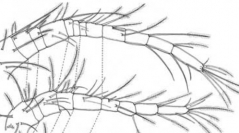

 Zoosystema
22 (4) - Pages 749-806
Zoosystema
22 (4) - Pages 749-806The development of the antennules through the copepodid phase to adult female was studied in 35 species representing to 29 genera of the subfamilies Euryteinae, Halicyclopinae, Eucyclopinae and Cyclopinae of the family Cyclopidae. The homology of the antennulary segments was established by comparing the distribution of the setae on each expressed segment with reference to the position of particular elements recognized here as markers. Ten developmental patterns were recognized. The most common pattern generates adult female antennules with 11 to 17 expressed segments, and is found in Cyclops sp., Megacyclops viridis s.l., Acanthocyclops sp., Mesocyclops meridianus, Thermocyclops decipiens, Kieferiella delamarei, Macrocyclops albidus albidus, Troglocyclops janstocki, Diacyclops bicuspidatus odessanus, D. uruguayensis, Metacyclops laticornis, M. hirsutus, Microcyclops anceps anceps, M. ceibaensis, M. alius, Apocyclops dengizicus, Hesperocyclops stocki, Speocyclops racovitzai, Graeteriella (Graeteriella) brehmi, Bryocyclops caroli, Muscocyclops operculatus and Fimbricyclops jimhensoni. A second pattern was shared by Tropocyclops schubarti schubarti, Cryptocyclops linjanticus and Apocyclops procerus. The third pattern links together Neutrocyclops sp. and Allocyclops silvaticus. Afrocyclops gibsoni, Ancheuryte notabilis, Eucyclops (Eucyclops) ensifer, Neocyclops (Neocyclops) vicinus, Paracyclops chiltoni, Halicyclops aberrans and two species of Ectocyclops (E. strenzkei and E. rubescens), each having unique development patterns. After the moult to copepodid I, new segments are formed only in the median and proximal regions of the antennule. An increase in the number of segments due to the expression of new intersegmental articulations was commonly observed during the ontogeny of the antennules. Reduction in expressed segment numbers occurred within phylogenetic lineages due to failure of expression of intersegmental articulations, but fusion of previously separate segments was never observed in females. Eight species of Cyclopinae and one of Halicyclopinae have neotenic antennules in which segmentation patterns typical of earlier copepodid stages are retained in adults. The significance of antennulary developmental data in establishing a robust scheme of phylogenetic relationships between the taxa within the Cyclopidae is emphasized.
Cyclopidae, copepodid, antennule, development.